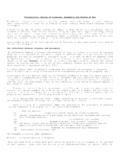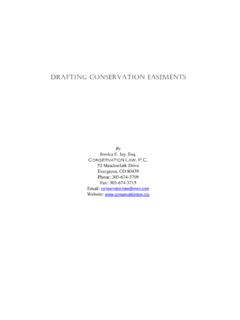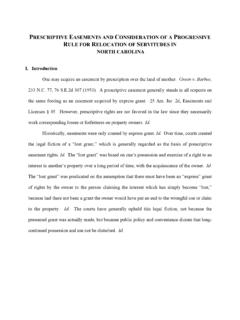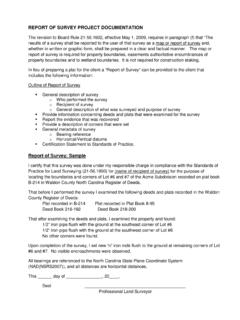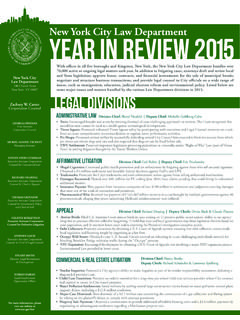Transcription of EASEMENTS Chapter 5: Easements - Private Roads …
1 Page 47 Wednesday, April 17, 2013 10:33 AM. EASEMENTS 47. Chapter 5: EASEMENTS EASEMENTS . Introduction 5-0. This Chapter deals with Private rights of way and other some other rights in 5-0. the same legal class known as EASEMENTS . Much of the law in this area comes from decisions of the courts, though the Prescription Act 1832 is particularly relevant 1 , and the Land Registration Act 2002 has had an important impact on the creation of EASEMENTS *. *See 2-21. What is an easement? An easement is a right to make limited use of someone else's land. Such rights 5-1. cannot exist independently2 the law requires that an easement is attached to one piece of land, and confers the right to make some use of another, nearby (not necessarily adjoining) piece of land in separate ownership.
2 The first piece of land is said to have the benefit of the easement, and the second to be burdened with it3. An easement must generally last either indefinitely, or for a fixed period of 5-2. time. The use allowed by an easement must not be so great that it prevents the owner of the land making reasonable use of his land. The right most commonly forming the subject of an easement is a Private 5-3. right of way: the right is attached to one piece of land and allows the owner of that land to use another piece of land (usually a road or path) for access. Many other sorts of easement are possible, and some are considered briefly at the end *See also Chapter 6 on of this Chapter .
3 In each case, the effect of the easement is to allow some specific parking. and limited use of land, for the benefit of nearby land*. There are two main ways in which EASEMENTS may be created expressly, 5-4. or by prescription. As to the former, EASEMENTS are regarded by the law as being land, and the same formalities apply, so that a deed* is generally *See 1-34. required in order to create an easement4. Prescription depends upon use over a period of time. No deed is involved. These methods are considered below, in relation to rights of way. Several 5-5. other, less common ways in which an easement can be created should be noted briefly.
4 1. The law is widely regarded as unsatisfactory: see the Law Commission's report Making Land Work: EASEMENTS , Covenants and Profits a Prendre, published in June 2011. 2. See Voice v Bell (1994) 68 P&CR 441. 3. The land with the benefit of the easement is also said to be the dominant tenement , and the land subject to the easement is said to be the servient tenement . 4. EASEMENTS can be legal in nature, or equitable . This Chapter is concerned only with the former. Different rules apply to the latter: they can (for example) be created without a deed, or for uncertain periods of time. Barsby Ltd 2013. Page 48 Wednesday, April 17, 2013 10:33 AM.
5 48 Private Roads . 5-6 The rule in Wheeldon v Burrows5 The common law contains a rule which applies where part of an area of land is sold off. The rule is that where one part of the land enjoys a continuous and apparent right over the other part, so that there would be an easement if the two parts were in separate ownership, and if that right was necessary for the enjoyment of the land, the right will become an easement when part is sold off. Suppose, for example, that the owner of a house in a Private road was also the owner of the road. He would use the road for access, and would be entitled to do so because he was the owner of it.
6 There would be no easement, because the house and the road were not in separate ownership. But if the road was sold the law would, under this rule, create a right of way over the road, even if none was expressly created when the road was sold, so that the new owner of the house would have the benefit of a right of way. 5-7 Section 62 of the Law of Property Act 1925 This provision also applies when part of an area of land is sold (unless it is excluded), and has a similar effect, creating an easement; though this provision can apply not just where the right is necessary but where it is merely convenient. 5-8 Implied EASEMENTS If a transfer of land would leave it landlocked , without access, the law will generally imply the grant of a right of way in order for the land to be accessed6.
7 Rights of way in a Private road 5-9 Most Roads are highways maintainable at the public expense, open to all classes of traffic because they are carriageways*. The public right of way is all *See 3-3. that is required in order for residents to be able to access their properties. This is equally true in a Private road which is a carriageway ( a highway for all classes of traffic*). 5-10 But in a Private road which is not a carriageway each house needs its own legal right of access, for vehicles and other traffic, over the road. This is accomplished by means of a Private right of way in the form of an easement. *But see 4-13 on- The easement is attached to the house, and the road is subject to it.
8 The right wards, on public rights of way for me- of way remains permanently in place when the house and the road change chanically propelled hands. vehicles. 5. (1879) 12 Ch D 31. 6. See Adealon International Proprietary Ltd v London Borough of Merton [2007]. EWCA 362; [2007] 1 WLR 1898. Barsby Ltd 2013. Page 49 Wednesday, April 17, 2013 10:33 AM. EASEMENTS 49. A right of way d el Fi A. Track Public road The field and track belong to a farmer. He grants a right of way (an easement) over the track, for the benefit of the plot marked A, so that some backland development can take place. Plot A has the benefit of the right of way (and is the dominant tenement ).
9 The track (the servient tenement ) is subject to it. A right of way in the form of an easement must be distinguished from: 5-11. A public right of way. Public rights of way exist for the benefit of the public generally, and do not belong to anyone in particular. They are not legally a form of property, and cannot be bought and sold. It is principally the role of the local authority, on behalf of the public at large, to safeguard public rights of way*. By contrast, an easement is essentially a Private *See chapters 3. and 4. matter between the current owners of the two pieces of land concerned. 5-12. Mere permission to use the road.
10 Like any other landowner, the owner of a Private road can give permission (a licence ) for the use of his property for access, or for other purposes, without granting any *See 1-48 onwards permanent rights*. Mere permission is not a satisfactory long-term for licences. arrangement, because it is personal in nature and will not be passed on automatically to the new owner of a property. 5-12. A wayleave. The utility companies, which supply water, gas, electricity and other services are given, by statute, the right to install pipes, wires *See generally Chapter and other equipment under or on the land. Such rights are sometimes 10.
